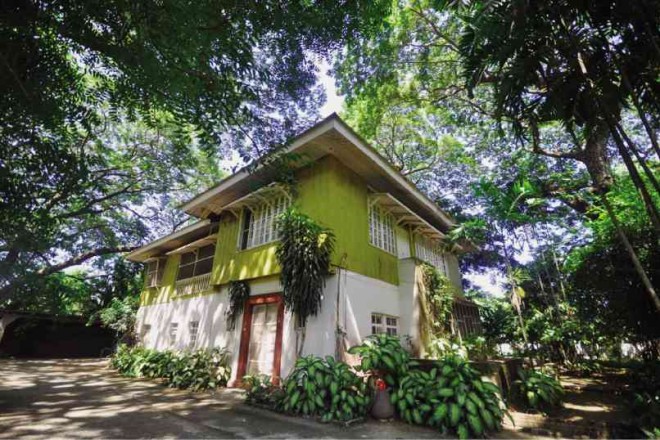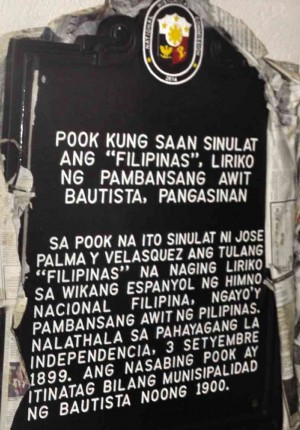The home of ‘Lupang Hinirang’

CASA Hacienda, the house where poet Jose Palma wrote the lyrics of the Philippine National Anthem, as it stands today in Barangay Poblacion Weste in Bautista, Pangasinan.
Bautista, Pangasinan, Philippine national anthem, ‘Lupang Hinirang’
EXCEPT for its residents, hardly would anyone know that it was in Bautista, a southeastern town in Pangasinan, where poet Jose Palma wrote the original lyrics of the Philippine national anthem more than a century ago.
This is because the old house, called Casa Hacienda, inside a fenced 1.5-hectare compound in Barangay (village) Poblacion Weste, still has nothing visible to mark its significance to the country’s quest for independence.
Shrine
But Mayor Amadeo Espino says the town government is moving closer to building a shrine in the area. He says the National Historical Commission of the Philippines (NHCP) has approved a design for the shrine and has committed P1.7 million in funds.
Article continues after this advertisementThe shrine, which will be built on a 150-square meter area near the Casa Hacienda, will consist of a 2.7-meter tall obelisk and a 1.2 x 2.1 m vertical panels on its sides, where the Spanish and Filipino lyrics of the national anthem will be inscribed.
Article continues after this advertisementIn front of the panel is a 3 x 4 m elevated platform, where Palma’s statue is shown seated, writing the lyrics of the national anthem on a desk. A brass marker from the NHCP will be put up in front of the platform.
Espino says since the NHCP budget was just for the shrine, his brother Gov. Amado Espino Jr. had approved a P2-million financial assistance for the shrine’s ground development.
Mayor Espino says the local government is only waiting for the landowners’ consent to start the shrine construction.
“I have presented the plan to one of the landowners, who was here last week, and he said he was very willing to donate part of their property. But he said he would just have to talk to his two siblings,” he says.
Historian Miguel Jurilla, head of the town’s office for senior citizens’ affairs, says the property used to be owned by Smith Bell, an American company that operated rice mills in Pangasinan during the Spanish period.
“It was eventually acquired by the Favis family, the grandparents of the late [beauty queen-turned-activist] Maita Gomez,” says Jurilla, 80.
The property, he says, was part of a hacienda established by the Spaniards during their colonization of the country. It used to have a cross-shaped, two-story concrete and wooden house with balconies on its sides and façade.
Gen. Luna’s retreat
Jurilla says the owners of Smith Bell lived in this house, which also served as its payroll office. During the Philippine-American War in 1899, it was in Casa Hacienda where retreating Gen. Antonio Luna temporarily held office and established the Department of War.
Luna, who was being hunted by the Americans at that time, was accompanied by the staff of “La Independencia,” the newspaper of the Philippine Revolution against Spain.
But Palma, who edited the newspaper’s Tagalog section, was not with the group at that time because he was detained in Manila. He joined the Katipunan in 1896 as a soldier but Luna took him in after he put up La Independencia.
Upon his release, Palma resided in Bautista, where he wrote the poem “Filipinas,” which was published in the first anniversary issue of La Independencia on Sept. 3, 1899.
Translated lyrics
Palma’s poem became the lyrics of the then “Marcha
Nacional Filipina,” a hymn composed by Julian Felipe that was played by the San Francisco de Malabon band during the proclamation of Philippine
independence in Kawit, Cavite, on June 12, 1898.
Jurilla says the staff members of La Independencia may have been the first to sing the poem to the tune of the “Marcha” while they were at Casa Hacienda. These included Cecilio Apostol, Palma’s brother Rafael, Fernando Ma. Guerrero, Epifanio de los Santos and Rosa Sevilla de Alvero.
In the 1940s, Julian Cruz Balmaceda, Ildefonso Santos and Francisco Caballo translated the lyrics to Filipino. This was approved as the national anthem in 1948. The Filipino translation was revised to its final version, “Lupang Hinirang,” which Filipinos use today.
Aguinaldo’s office
Jurilla says it was also in Casa Hacienda where then President Emilio Aguinaldo held office as he was being pursued by American forces in 1899.
“That is why Bayambang [town] was once our country’s capital because our town (Bautista) used to be called Telbang, a barrio of Bayambang,” he says.
Telbang became a town in 1900 and was renamed Bautista, in honor of its patron saint, St. John the Baptist.
In November 1899, American Brig. Gen. Arthur MacArthur took over Casa Hacienda and turned it into a headquarters of the 2nd Division, 8th Army Corps of the United States Army.
The house was also converted into a garrison by the Japanese Imperial Army during World War II. “It survived air raids and bombings during World War II because of the trees surrounding it,” Jurilla says.
What remained of the Casa Hacienda now is only its middle part. Although its upper walls had been painted with yellow, the original materials remained.
The dining, receiving and living rooms at the ground floor and bedrooms on the second floor are still intact and only the balconies are gone now.
